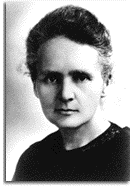

Pomona College Chemistry Department's Online Periodic Table
Radium
Back to Pomona College Chemistry Department
The Basics | Etcetera | History | On Earth | Radioactive Nature | Everyday Uses | For Your Health | My Sources
Atomic Number: 88
Atomic Mass: 226.0254 g
Atomic Volume: 39.0 cm3/mol
Density: 5.8 g/cm3
Melting Point: 700°C
Boiling Point: <1140°C
Crystal Structure: Cubic Body Centered
Oxidation State: 2
Ground State Electron Configuration: [Rn]7s2
Electronegativity: 0.9
pH Properties: Basic
Common Isotopes: Ra 226
Category: Alkaline Earth Metal
Zeff: 4.36
Polarizability: 38.3
Enthalphy of atomization: 163 kJ/mol (25°C)
Thermal Conductivity: 0.186 W/ch/K (25°C)
First Ionization potential: 5.279 eV
Radium is Latin for radius, or ray. The element was discovered in 1898 by Marie and Pierre Curie in North Bohemia, where it occurs naturally in the pitchblende or uranite. It was first isolate by Marie Curie through the electrolysis of a radium chloride solution, using a mercury cathode. Upon distillation in an atmosphere of hydrogen, this amalgam yielded the pure metal!
Because of the radioactive nature of radium, and the fact that Mme. Curie first isolated the radium element, the unit for radioactivity is called the curie (Ci). She also earned two Nobel Prizes for her work towards further understanding radium, especially its radioactive nature. In fact, after her extensive study of radium, and later uranium, Marie Curie became and advocate of X-ray technology, teaching over 150 women to use X-rays to aid doctors around the time of World War I. Unfortunately, from their continued work with the radioactive element, both Marie and her husband Pierre became sick from overexposure. After winning a Nobel Prize in Physics and Chemistry, and founding the "Radium Institute" in Paris, Marie died in 1934. Subsequently the "Radium Institute" was renamed the "Curie Institute." The Institute is still in existence today, however, Marie's notebooks in which she recorded all of her findings are, to this day, still locked up - they are too radioactive to handle.

Marie Curie
Polish/French Physicist
1867-1934
Where is radium found?
Radium was first found in Bohemia in the rich pitchblence ore. Some can also be found in the Carnotite sands of Colorado, although richer supplies exist in regions of Zaire, Africa and the Great Bear Lake region of Canada.
Radium is present in all uranium metals, and can be extracted from the waste products of uranium processing.
What does it look like?
Radium, when in its pure metal form, is a brilliant white while fresh. However, it blackens when exposed to air, due to the formation of radium nitride on the surface. It exhibits luminescence, decomposes in water, and is more volatile that its fellow alkaline earth metal, barium (Ba). When put to a flame, radium displays a red carmine color.
Where can I get it?
Commercially, radium can be obtained in its salt form, as either radium bromide or radium chloride. It is doubtful that any significant stock of the isolated element currently exists. In the 1940's, when radium was in high demand for X-rays and other war-related uses, the price per gram of radium fluctuated, but eventually the Canadians got it down to $10,000 per gram. Since it does not exist in its pure form now, there is no standard price per gram.
The Radioactive Nature of Radium
Radium displays the radioactive properties that give it its name. It emits alpha, beta, and gamma rays. It also produces neutrons when mixed with beryllium (Be). The curie (Ci) is the amount of radioactivity that has the same disintegration rate as one gram of Ra226, which is 3.7 x 1010 disintegrations per second.
There are sixteen known isotopes of radium. Radium 226 is the most common isotope, with a half-life of 1620 years. The product of its disintegration is radon gas, which is chemically inert. As radium disintegrates, it loses 1% of its activity every 25 years. The final product of this disintegration is lead (Pb)
Radon gas is used in Radiotherapy, and due to its short half-life ( 4 days ) it can only be obtained in trace quantities. When it is isolated, the gas is sealed in minute tubes and used to treat cancer and other diseases.
Radium is also used in self-luminous paints, various medicines, and as a source of neutrons.
As you might expect, the radioactive properties of radium make it dangerous for humans. It is a radiological hazard, meaning that inhalation of, injection of, or bodily exposure to radium can cause cancer and other disorders. The maximum permissible burden for the human body for Ra226 is 0.2 µCi. As with Marie Curie, overexposure can cause a variety of health problems, from tuberculosis to cancer.
For more information on radium, check out:
CRC Handbook of Chemistry and Physics. Editor David R. Lyde, Ph.D. Boston: CRC Press, 1990.
For more information on Marie Curie, try:
http://zen.sunderland.ac.uk/~hb5hco/open.htm
http://www.france.diplomatie.fr/label_france/ENGLISH/SCIENCES/CURIE/marie.html
This page was constructed by Stefanie. Comments and suggestion? sam02000@pomona.edu.